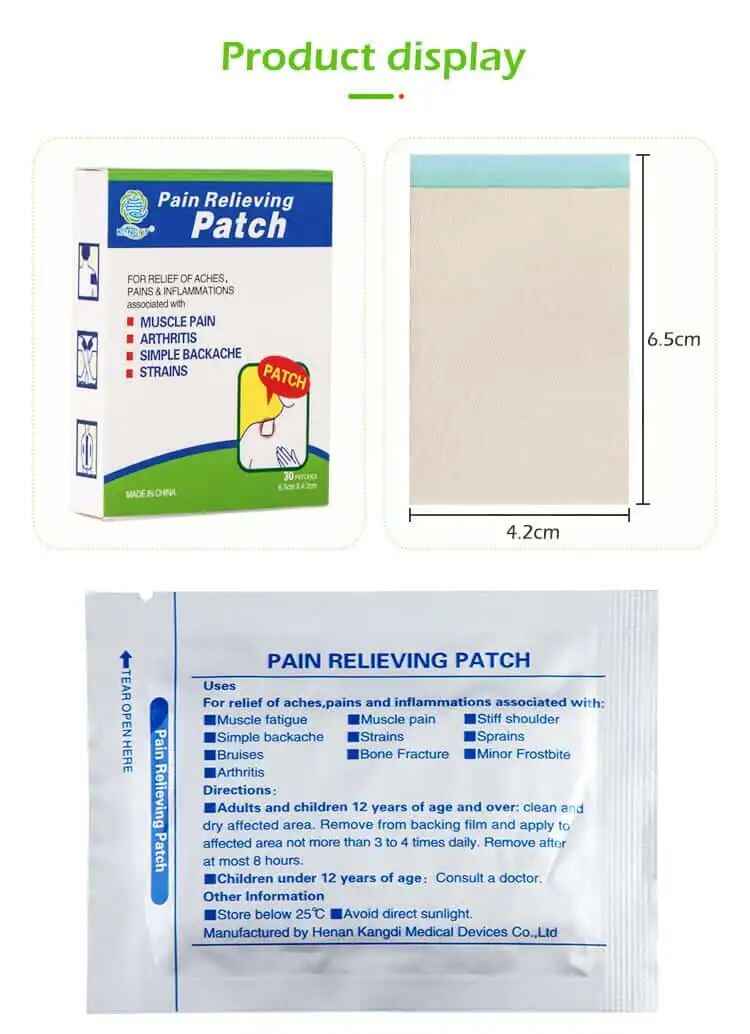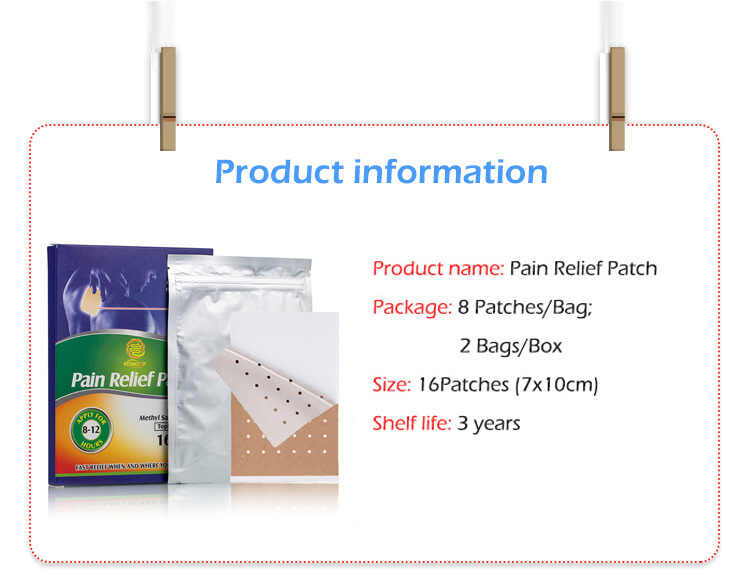How Do Heat Therapy Patch Manufacturers Ensure Product Safety?
Ensuring product safety is paramount in the production of Heat Therapy Patches, especially when partnering with a Heat Therapy Patch Manufacturer or sourcing Custom Heat Therapy Patches from a Heat Therapy Patch OEM. These products, which offer relief from muscle pain, stiffness, and discomfort, must be designed with both efficacy and safety in mind to protect consumers from potential harm. Whether you're sourcing from a Heat Therapy Patch Supplier or creating a Private Label Heat Therapy Patch, understanding the processes and measures that manufacturers employ to ensure safety is critical. This article will explore how Heat Therapy Patch Manufacturers maintain high safety standards through careful material selection, rigorous testing, regulatory compliance, and quality control procedures.

1. Material Selection: The First Step in Ensuring Safety
The foundation of any safe Heat Therapy Patch begins with choosing the right materials. Heat Therapy Patch Manufacturers select materials based on their suitability for prolonged skin contact, heat generation, and durability. Materials must be hypoallergenic, non-toxic, and capable of withstanding heat over extended periods without degrading or releasing harmful chemicals.
Key Materials Used in Safe Heat Therapy Patches:
Non-Irritating Adhesives: The adhesive used to attach the patch to the skin must be gentle to avoid skin irritation. Silicone-based adhesives are often chosen for their hypoallergenic properties.
Heat-Producing Ingredients: The most common heat-producing ingredient is iron powder, which undergoes a slow oxidation process to produce heat. This is favored because it’s safe and can deliver a consistent, controlled heat.
Breathable Backing Layers: Materials like polyester, nonwoven fabrics, and polyurethane are used for the backing layer to ensure that the patch stays secure on the skin without trapping moisture or heat, which could lead to burns or other skin issues.
By working closely with a reputable Heat Therapy Patch Supplier, manufacturers can ensure that all materials meet the required health and safety standards, significantly reducing the risk of adverse reactions.
2. Rigorous Testing to Verify Safety and Effectiveness
Before a Heat Therapy Patch OEM product reaches the market, it undergoes rigorous testing to verify its safety, efficacy, and compliance with regulatory standards. These tests are crucial in detecting any potential issues that could affect consumer health or the product's performance.
Key Tests Performed on Heat Therapy Patches:
Dermatological Testing: Heat therapy patches must undergo dermatological safety tests to ensure that they do not cause skin irritation or allergic reactions. These tests assess the adhesive, heat-producing ingredients, and overall patch design to confirm they are safe for prolonged skin contact.
Heat Consistency Tests: Manufacturers test the heat generation and duration to ensure that the patch provides a stable and consistent heat output. This involves measuring how long the heat lasts, whether it’s too hot for the skin, and if it delivers the promised therapeutic effects.
Toxicological Testing: Testing for harmful chemicals, toxins, or any volatile organic compounds (VOCs) is crucial. Toxicology reports ensure that no hazardous substances are present in the patch materials that could negatively affect consumers’ health.
Microbial Testing: Heat therapy patches must be free from microbial contamination, particularly since they are often applied to broken skin or areas prone to sweating. Manufacturers perform tests to ensure that the patch does not harbor harmful bacteria or fungi.
By adhering to these testing protocols, Custom Heat Therapy Patch manufacturers ensure that the final product is both effective and safe for consumers, reducing the likelihood of complaints or product recalls.
3. Compliance with Regulatory Standards
A Heat Therapy Patch Supplier must ensure that its products comply with relevant national and international regulatory standards. Regulatory bodies such as the U.S. Food and Drug Administration (FDA), Health Canada, and European Medicines Agency (EMA) impose strict guidelines on the production of medical and therapeutic products, including heat therapy patches.
How Heat Therapy Patch Manufacturers Ensure Compliance:
FDA Approval (for the U.S. Market): In the U.S., Heat Therapy Patches are typically regulated as medical devices by the FDA. Manufacturers must adhere to FDA's Good Manufacturing Practices (GMP) and submit their products for approval to ensure that they meet the necessary safety standards.
ISO Certification: Many Heat Therapy Patch Manufacturers seek ISO 13485 certification, which demonstrates adherence to quality management systems for medical device manufacturing. This certification ensures that the manufacturer follows strict controls to ensure product safety and effectiveness.
CE Marking (for the EU Market): In Europe, heat therapy patches must bear the CE mark, signifying that they comply with European health, safety, and environmental protection standards.
Labeling Requirements: Regulatory agencies often have strict labeling requirements to ensure that the product is safe for consumer use. Manufacturers are required to include clear instructions, warnings, and ingredient disclosures on the product packaging.
By meeting these regulatory standards, Private Label Heat Therapy Patch manufacturers can assure their customers that the product is safe and legally compliant in the markets where they are sold.
4. Quality Control Throughout the Manufacturing Process
Quality control is a continuous process that ensures that every batch of Heat Therapy Patches is free from defects and meets the established safety standards. Heat Therapy Patch OEM manufacturers implement strict quality control procedures to maintain consistency and safety from the beginning to the end of production.
Key Quality Control Measures in Heat Therapy Patch Production:
Raw Material Inspection: Before production begins, raw materials such as adhesives, heat-producing ingredients, and backing materials undergo thorough inspection to confirm their quality and suitability.
In-Process Testing: During manufacturing, samples from each production batch are taken and tested for consistency in heat output, adhesive strength, and skin compatibility. This ensures that each batch performs as expected and is free from defects.
End-of-Line Inspection: Finished products undergo a final inspection to verify that they meet all safety requirements. This includes checking for proper heat distribution, secure adhesive bonding, and ensuring that the packaging is intact.
Batch Testing: For larger manufacturers, batch testing is crucial to maintain consistency across large production runs. Samples from each batch are tested to ensure uniformity in heat performance and adhesion.
By maintaining these rigorous quality control procedures, Heat Therapy Patch Suppliers ensure that each product consistently delivers safe and effective results to consumers.
5. Packaging and Labeling for Safety
Packaging and labeling are essential components of heat therapy patch safety. Proper packaging ensures that the product remains uncontaminated before use, while labeling provides users with the necessary instructions to use the product safely.
Packaging Safety Measures:
Tamper-Evident Packaging: Heat therapy patches are typically packaged in tamper-evident materials to prevent contamination or damage during shipping and handling.
Protective Layers: Many heat therapy patches include protective liners that prevent the adhesive from sticking prematurely, ensuring that the patch remains safe and functional until it's applied.
Labeling for Safe Use:
Instructions for Use: Clear, easy-to-follow instructions on how to apply and wear the patch help prevent misuse or overuse, which could lead to burns or discomfort.
Warnings and Precautions: Labels must include warnings for individuals with sensitive skin, specific temperature ranges, and duration recommendations to avoid overheating or prolonged exposure.
Effective packaging and labeling ensure that consumers are fully informed about how to use the product safely and that they understand any potential risks.
6. Post-Market Surveillance and Consumer Feedback
Even after the product reaches the market, Heat Therapy Patch Manufacturers continue to monitor the product’s safety and effectiveness. Consumer feedback, adverse event reports, and ongoing clinical studies are used to track any safety concerns that might arise post-launch.
Post-Market Monitoring Measures:
Consumer Feedback: Manufacturers often establish channels for consumers to report any adverse reactions or issues with the patch. This feedback can lead to product improvements or adjustments in future batches.
Recalls and Safety Alerts: If any issues are identified, manufacturers must act swiftly to issue recalls or safety alerts. Proactive monitoring ensures that consumers are protected and that any safety issues are addressed immediately.
Conclusion
Ensuring the safety of Heat Therapy Patches is a multifaceted process that involves careful material selection, thorough testing, regulatory compliance, and continuous quality control. Whether you're working with a Heat Therapy Patch Supplier, sourcing from a Heat Therapy Patch Manufacturer, or developing Private Label Heat Therapy Patches, these processes are critical to ensuring that the product is safe, effective, and compliant with health standards. By adhering to strict safety protocols and regulations, manufacturers can provide consumers with a high-quality product that delivers therapeutic benefits without compromising safety.
Frequently Asked Questions
1. How do manufacturers ensure the safety of Heat Therapy Patches?
Manufacturers ensure safety through rigorous testing, including dermatological, heat consistency, and toxicological tests, as well as by selecting non-toxic, hypoallergenic materials.
2. What types of materials are used to ensure a safe Heat Therapy Patch?
Safe materials include hypoallergenic adhesives, iron powder for heat generation, breathable fabrics for backing, and silicone-coated protective films.
3. Are Heat Therapy Patches regulated for safety?
Yes, Heat Therapy Patches must meet regulatory standards such as FDA approval in the U.S., CE marking in Europe, and GMP practices to ensure product safety and efficacy.
4. How do manufacturers control the quality of Heat Therapy Patches during production?
Manufacturers implement quality control measures like raw material inspection, in-process testing, and end-of-line checks to ensure each patch meets safety and performance standards.
5. Why is labeling important for Heat Therapy Patches?
Proper labeling provides consumers with usage instructions, warnings, and precautions to ensure safe application and avoid potential risks like burns or irritation.






